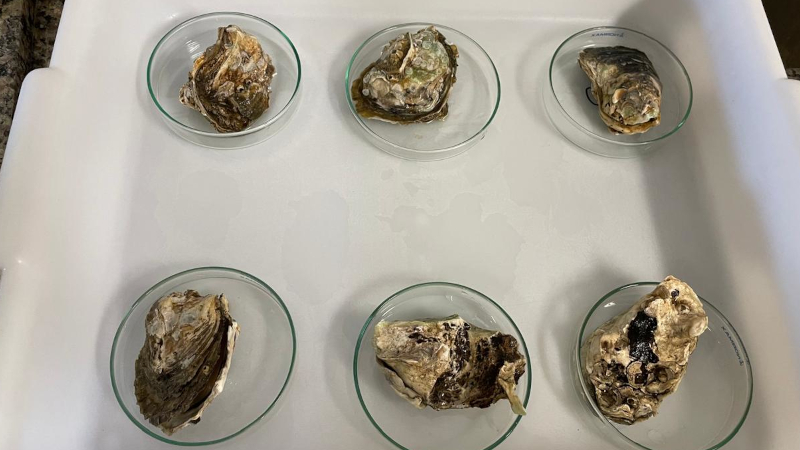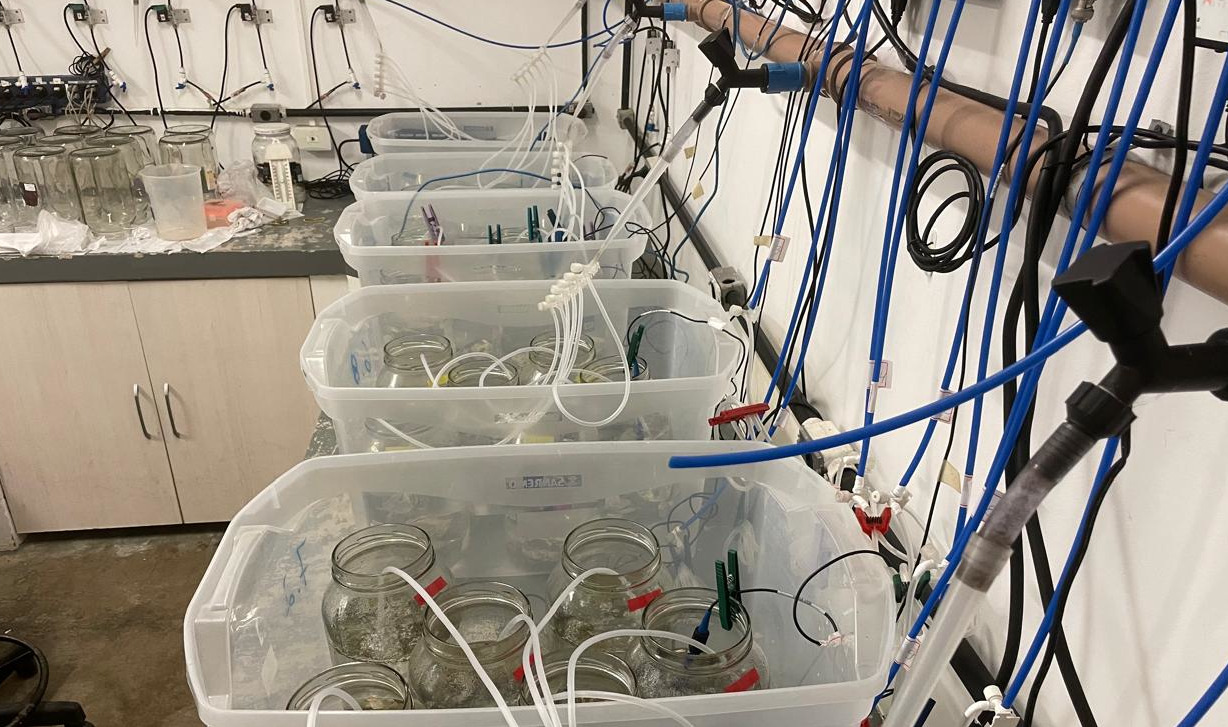

Scientists conducted laboratory tests on mangrove oysters (Crassostrea gasar) to assess the toxicological effects of compounds in the synthetic drug derived from amphetamine (photo: Andressa Ortega/Coastal Experimental Campus, Institute of Biosciences-UNESP)
Researchers at the Federal University of São Paulo found that the toxicological effects of the drug on marine animals may be greater than those of cocaine. Preliminary results of the study were presented during the São Paulo School of Advanced Science on Emerging Pollutants.
Researchers at the Federal University of São Paulo found that the toxicological effects of the drug on marine animals may be greater than those of cocaine. Preliminary results of the study were presented during the São Paulo School of Advanced Science on Emerging Pollutants.

Scientists conducted laboratory tests on mangrove oysters (Crassostrea gasar) to assess the toxicological effects of compounds in the synthetic drug derived from amphetamine (photo: Andressa Ortega/Coastal Experimental Campus, Institute of Biosciences-UNESP)
By Elton Alisson | Agência FAPESP – After confirming the presence of cocaine not only in the water but also in sediments and marine organisms in the Bay of Santos – a city in the state of São Paulo, Brazil, and home to the largest port in Latin America – researchers from the Federal University of São Paulo (UNIFESP) and collaborators are assessing the potential risks posed by another emerging pollutant: MDMA (3,4-methylenedioxymethamphetamine), commonly known as ecstasy or “love pill.” Although the substance has not yet been detected on the São Paulo coast, there are concerns that it will be due to increased consumption in Brazil.
To assess the possible toxicological effects of the original and metabolized compounds of this synthetic amphetamine-derived drug on marine animals, which can reach lakes and seas after being excreted due to the ineffectiveness of sewage treatment plant removal processes, researchers conducted laboratory tests with mangrove oysters (Crassostrea gasar).
The results of the tests on this Brazilian species of oyster, which is recognized as an excellent sentinel organism for assessing the environmental impacts of pollutants due to its bioaccumulation capacity, indicated that ecstasy may have greater toxicological effects on marine animals than cocaine.
Some of the main conclusions of the study, supported by FAPESP, were presented during the São Paulo School of Advanced Science on Emerging Pollutants, which took place from September 2 to 13 in Santos.
“Ecstasy consumption is beginning to grow in Brazil, especially in the state of São Paulo. Although the concentration is theoretically lower in the sea, its toxicity may be higher. Therefore, the toxic effects on marine animals are more severe,” Camilo Dias Seabra, a professor at UNIFESP and coordinator of the project, told Agência FAPESP.
The researchers found that exposure to MDMA caused significant lethal (5,000 nanograms per liter [ng/L-1]) and sublethal (5 to 50 ng/L-1) effects in mangrove oysters, especially at environmental concentrations, indicating the oysters’ sensitivity to this contaminant.
In previous trials assessing the effects of cocaine exposure on brown mussels and eels, the researchers found that impacts on these animals were observed at lower concentrations of the drug than those associated with ecstasy. “The effects of ecstasy on these marine animals may be severe compared to those of cocaine,” Seabra pointed out.

Exposure of mangrove oysters to MDMA caused lethal and sublethal effects (photo: Andressa Ortega/CLP-IB-UNESP)
Partnership
For the past ten years, the UNIFESP group has been conducting ecotoxicological studies on emerging pollutants found in coastal areas in Brazil, such as the Bay of Santos, in collaboration with colleagues and students from the Coastal Experimental Campus of the São Paulo State University (UNESP) and Santa Cecília University (UNISANTA).
They have identified substances, such as ibuprofen, paracetamol, and diclofenac, as well as caffeine, cocaine, and its metabolite benzoylecgonine, in environmentally relevant concentrations in water, sediments, and marine organisms throughout the São Paulo coastal region (read more at agencia.fapesp.br/51499).
For this recent study, the researchers obtained MDMA samples from Europe that had been seized by São Paulo Civil Police officers at the Port of Santos and donated to the UNIFESP laboratory in Santos with judicial authorization.
This partnership with the police and the judiciary has been fundamental to the continuity of studies and advancing knowledge about the environmental and human health risks of illicit drugs and their metabolites, which are considered pollutants of emerging concern and are not included in environmental monitoring legislation, Seabra points out.
“Since we have samples of these super-pure drugs in the laboratory, with the authorization of the courts, we can understand the environmental impacts and impacts on marine organisms. This allows us to conduct larger experiments at high concentrations,” he said.
Seabra pointed out that the involvement of the police and the courts in making these projects possible also gives Brazilian researchers an advantage over other international laboratories conducting studies in this area. Often, these laboratories do not have access to the necessary quantities of drug samples to carry out tests.
Marco Parolini, one of the world’s leading experts on the ecotoxicological effects of illicit drugs, a professor at the University of Milan, and one of the SPSAS’s foreign guests on Emerging Pollutants, said during the event that he does not have the same level of access to super-pure drug samples as Brazilian researchers. “Access to these drugs in Italy, even for scientific purposes, is highly restricted,” he compared.
On the other hand, the police have also benefited from the results of studies conducted by Brazilian researchers. Based on records of illicit cocaine and its metabolite, benzoylecgonine, found in water, sediments, and marine organisms in urban canals, coastal rivers, beaches, submarine outfalls, and estuaries, the presence of drugs in waterways along the São Paulo coast has become clearer.
“Seasonal monitoring of illicit drugs such as cocaine in coastal environments is essential in Brazil, as they have become an environmental problem on the Brazilian coast,” said Seabra.
The concentrations of cocaine recorded by researchers in the Bay of Santos, for example, are a thousand times higher than those found in San Francisco Bay in the United States. However, in addition to Santos, the presence of the drug and benzoylecgonine has been recorded in marine animals in other Brazilian coastal cities.
In July 2024, researchers from the Oswaldo Cruz Institute published the results of dissecting 13 small sharks native to the waters of Recreio dos Bandeirantes, a neighborhood in Rio de Janeiro. The Rhizoprionodon lalandii sharks, which were accidentally caught by fishermen, were contaminated with cocaine and benzoylecgonine. “This is becoming a problem in the marine environment off the Brazilian coast,” said the researcher.
Emerging issue
The event on emerging contaminants, promoted by the Institute of Environmental, Chemical, and Pharmaceutical Sciences at UNIFESP and supported by FAPESP through the São Paulo School of Advanced Science (SPSAS) program, aimed to contribute to the training of professionals capable of addressing this and other issues. It sought to develop and deepen technical knowledge and broaden the application of multi- and interdisciplinary approaches. Additionally, it aimed to raise awareness about the topic and its diverse nature, potential risks, and possible solutions by providing a multidisciplinary platform.
During the 12-day program, participants took part in activities such as theoretical and practical classes on sampling and analysis methods, ecotoxicological studies, and remediation methods. They also went on field trips, studied case studies, took part in roundtable discussions, attended technical lectures, and participated in a hackathon to encourage intellectual collaboration. This was later expanded upon in small groups tutored by professors.
The School gathered an audience consisting of undergraduate, master’s, doctoral, and postdoctoral students from different Brazilian states and various countries.
Republish
The Agency FAPESP licenses news via Creative Commons (CC-BY-NC-ND) so that they can be republished free of charge and in a simple way by other digital or printed vehicles. Agência FAPESP must be credited as the source of the content being republished and the name of the reporter (if any) must be attributed. Using the HMTL button below allows compliance with these rules, detailed in Digital Republishing Policy FAPESP.





